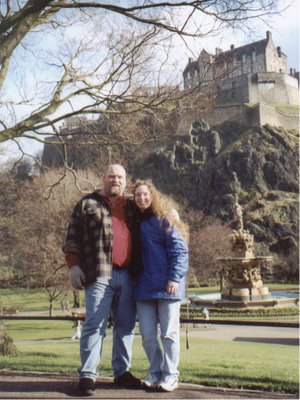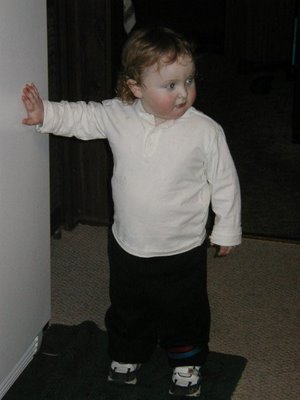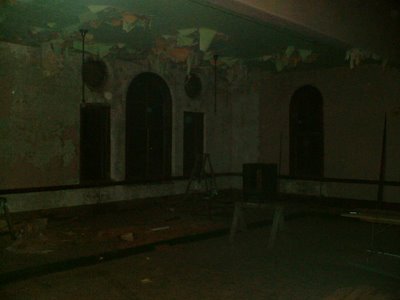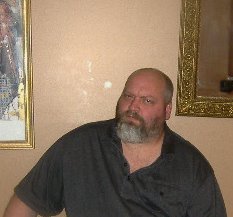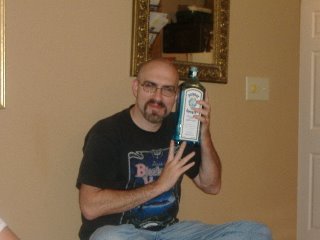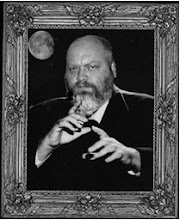Friday, June 30, 2006
More Wisdom from the keyboard of Steve McNallen
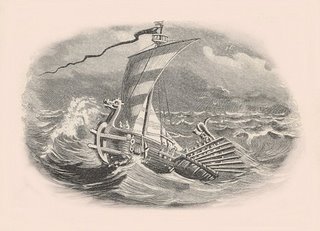 In Germanic cosmology there are two major features: the Well and the Tree. The Tree is the mighty Yew, the framework of the cosmos, and in it hang all the Nine Worlds. The Tree is all that which IS at any given instant.
In Germanic cosmology there are two major features: the Well and the Tree. The Tree is the mighty Yew, the framework of the cosmos, and in it hang all the Nine Worlds. The Tree is all that which IS at any given instant. The Well, on the other hand, is the repository of all that which has been - the past, if you will. As we go about our lives, our deeds deposit layers in that Well. These layers constitute our "fate," or more properly our orlog (or=primal; log=layers). These layers continue to influence the present. In other words, the layers we put in the Well help determine what happens to us. We get the fate we make, at least partially.
Philosophically, this is significant because it affirms free will and human effort while refuting fatalism.
However, it gets more complicated: We are not the only ones putting layers in the well. Our own deeds have greater immediacy for our own lives, but the outcome of events is also shaped by the deeds of others - vast forces, usually impersonal, that condition what can or cannot be done at any given time. Because the equation describing that-which-is is thus a complex one, we may not be able to get the outcome we desire in any given situation. The momentum of other layers in the Well may simply outweigh any power we can bring to bear.
It is here that heroism comes into play. Edith Hamilton, in her book Mythology, writes that "The hero can prove what he is only by dying." I read that line as a young man, and it took me years to truly understand it. A human may exert all his or her power (physical, mental, and spiritual) to attain a goal. This is a noble thing, but gaining victory is not the greatest test of heroism. The ultimate expression of the heroic ethic is to fight one's hardest and lose the battle - but to accept defeat calmly and meet death with a joke on one's lips. In other words, the enemy can take victory but they cannot take the dignity of the great soul; that remains forever under the control of the hero's will.
We can draw power from the past - from the Well itself - to aid us in our personal battles. The sumbel horn is, magically speaking, the Well. The mead within it is the accumulated orlog. By drinking from the horn with intent and invoking some specific form of that-which-has-been, we bring the might of the past into the present and immerse ourselves in it that we may use that might to seek our own victories. This involves making a toast (thus harnessing some of the Well-bound might of others, to include the Holy Powers themselves), a boast of a personal accomplishment (reaffirming our own layers laid down successfully) or some other mighty verbal gesture such as a song or poem that also captures the courage, power, endurance, or even the sense of humor expressed in the past.
While social bonding and the speaking of one's mind are valuable side effects of the sumbel, we would do well to remember the fundamental aim, which is to manifest the power of the past and apply it to our present and future struggles. As such, sumbel becomes a magical act of great significance, with immense benefits for the participants. I urge you to incorporate a verbal prologue at the beginning of your sumbels to take full advantage of this effect and to teach those who sit at your table!
Thursday, June 29, 2006
Re: Lucid Dreaming
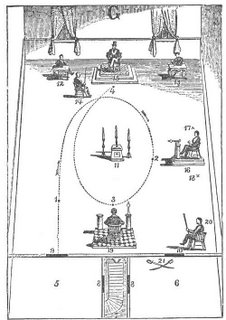
I've had several people ask me about these lucid dreams I've been having.
First, let me state, a "lucid dream" is one in which you are "aware" you are dreaming... you are fully conscious of what is transpiring, even if you are compelled to do things against your better judgement.
Now, as for the dream I have been experiencing:
I find myself fully aware in the Elwood Blue Room, but not as it is, but as it was...out of the corner of my eye dark shadowy figures are moving, but when I turn? Not there... I feel hot breath on my neck... I spin around to find nothing... The door to the back room opens... voices call me to it, but I can't make out what they're saying... As I near the door I see a veiled woman standing on the raised stage out of the corner of my eye, I look and she fades to nothing... I turn back to the door and pass through... then I wake up...
Almost every night for two weeks...
Damn, this is almost fun :)
I am so ready for Saturday Night...
Wednesday, June 28, 2006
Return to the Blue Room
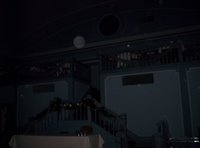 The Wabash Paranormal Investigation and Research Group's return to the Elwood Opera House and its preternaturally charged Blue Room has been moved up to this coming Saturday, July 1.
The Wabash Paranormal Investigation and Research Group's return to the Elwood Opera House and its preternaturally charged Blue Room has been moved up to this coming Saturday, July 1. As you can imagine, I am quite thrilled to be making a second trip to this overtly haunted site. After the events that transpired on our first visit, a second outing is just what the doctor ordered...
Keep your eyes peeled for a full report come Monday, July 3rd...
I should add that ever since the events at the Converse IOOF Building I have been having extremely lucid dreams... and I've been getting the sense that something is trying to communicate with me. I get the overwhelming impression that the spirits in the Opera House know we're coming... is it a sense of dread, or wonderment? Maybe a little of both.
Tuesday, June 27, 2006
The Giant's Dance
 The stones of Salisbury
The stones of SalisburyThe ancient world rises in awe across a vast plain in southern England, where Stonehenge and two lesser known neolithic monuments carry us back thousands of years
Story by The Gazette's DONNA NEBENZAHL
The debate over Stonehenge's historic use has raged for years.
Despite a car park, visitors’ entrance and roped-off enclosure, Stonehenge and its ancient majesty can take away a visitor’s breath.
Rising from its grassy bed on the Salisbury Plain, a vast plateau in southern England, is a circle of massive stones that have held generations in thrall.
Stonehenge, a 5,000-year-old megalithic ruin, is considered the most important prehistoric monument in Britain. Despite its attendant car park, visitors' entrance and roped-off enclosure, the sight of those massive stones set against the bowl of sky made me catch my breath.
Meandering slowly around the site, I regretted not being able to reach out and touch the stones as visitors were able to do in the past. Yet I understood fully the need to keep this captivating place safe from destruction. Not far away are another, wider stone circle, at Avebury, where one can wander among the stones, and a massive neolithic mound at Silbury Hill. Debate over the historic use of Stonehenge has raged for years, but what we do know today is that the "henge," meaning earthworks, is in actuality a series of earth, timber and stone structures remodelled over a period of more than 1,400 years.
The belief that it was built by the Druids is the most recent theory to go. These marsh and forest worshippers did use Stonehenge as a temple of worship when they moved into the region, but carbon dating has shown the monument was completed more than a thousand years before the Celts inhabited the area.
People who call themselves modern Druids still congregate here, especially to mark the summer solstice. The caretakers of the site, Britain's English Heritage, allowed "managed open" access to the site last Tuesday night so worshippers could attend the sunrise.
English Heritage also will allow groups or individuals visitors to view the site privately in the off-hours, if booked well in advance.
It's easy to see why people would want to walk amid the stones. Even on a bright summer day, with dozens of other visitors and the path around the site clearly marked to prevent the stones from being touched, there is a transporting majesty in the sight of these huge stones rising from the expansive plain.
How they came there continues to mystify. The earliest portion must have been the easy part, started around 3000 BC by neolithic agrarians known as the Windmill Hill people, a semi-nomadic hunting and gathering group. They built large circular hilltop enclosures around mounds where collective burials took place, known as barrows. At Stonehenge, they built a circular bank, a ditch, and an outermost bank of about 100 metres in diameter. For the next 500 years, post holes show the addition of more timber in the centre of the monument and the northeast entrance.
Next came the Beaker people, so named because of their tradition of burying their pottery drinking cups with their dead. They invaded the Salisbury Plain around 2000 BC. Considered warlike and industrious, they are believed to be the sun worshippers who aligned Stonehenge with the summer and winter solstices.
Then around 1500 BC, the Bronze Age, the Wessex people began work on the site. One of the most advanced European cultures outside the Mediterranean, precise in their calculations and construction, they are thought to have been the ones who created the Stonehenge we see today.
Bringing stones of that magnitude to the site, especially the ones that make up what is known as the Sarsen Circle - once 30 neatly trimmed upright sandstone blocks nine metres long and weighing 45 tonnes, of which 17 now stand - remains a spectacular feat. What gives this site added dimension - it's just one of a series of stone circles in the region - is that the lintels are at least partially intact. The stones, hard-grained sandstone, were probably brought from the Marlborough Downs, about 30 kilometres to the north.
The second stone circle we visit is much rougher, less easy to decipher. But the massive site at the Wiltshire village of Avebury, 145 kilometres west of London and 30 kilometres north of Stonehenge, has often been described as more evocative of humanity's place in a mysterious world, thought to be dedicated to the themes of sexuality and the cycle of life.
The site was built by the descendants of Windmill Hill, who are also credited with creating the long barrow at West Kennet, one of the most well-preserved burial chambers in Britain, constructed around 3500 BC and in use for a thousand years.
Unlike Stonehenge, Avebury's stone circle can be walked through, and as we wandered among the massive stones, we encountered a half-dozen sheep grazing on the grassy verge. The village of Avebury, in fact, lies partly within the henge, the stones enclosing an area of 11 hectares, with two smaller circles within.
This is the largest henge in Europe, said to have delivered myriad hauntings to the village that it surrounds. Our guide, eager to show us the mystical properties of the site, offered a divining rod that moved abruptly downward for everyone who carried it as they walked slowly across the grass. Did we feel the energy of the place, he asked?
The elements of Avebury do inspire a sense of great mystery. The ditch, once nine metres deep and surrounded by a nine-metre bank, was likely filled with water to isolate the sacred temple, some say. Four causeway-entrances, one at each compass point, cut through the henge. We discovered that the bank could have been a viewing area, like a grandstand, for people from the region who attended the special rituals and ceremonies that took place there.
To create the ditch, it is said that some 120,000 cubic metres of solid chalk were dug, 60 times more material than was dug from the ditch at Stonehenge. There were originally some 400 standing stones within the henge and forming the great avenues at Avebury, though mere dozens remains. The heaviest, the Swindon Stone, weighs about 65 tonnes.
The Avebury temple was in active use for some 700 years.
The final site in our neolithic excursion is one for which no real use has been found. Silbury Hill, located just south of Avebury, is a massive artificial chalk mound with a flat top - the tallest manmade prehistoric mound in Europe, rising to a height of 39.6 metres. Carbon-dating at 2660 BC would mean Silbury Hill was created during the same period as the Giza pyramids of ancient Egypt, and, although it looks like a mound, science has revealed that it is actually a step pyramid, consisting of six six-metre high steps, then covered with earth and grass.
We viewed it from a distance, and it was easy to see why there were so many wild tales attached to the mound. One legend has it that a huge bag of earth was dropped by the devil, prevented by the high priests at Avebury from burying the town of Marlborough; another claimed it was the burial place for a great king.
While not a burial mound, Silbury might hold a larger secret: it has been revealed that it is part of a sequence of ancient sites in the area, all in alignment.
Monday, June 26, 2006
On the near horizon...
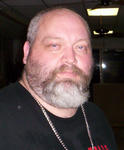
I will be appearing:
In the July issue of Insidious Reflections in an interview by Richard Hipson. Look for an excerpt from the Shadows Over Somerset sequel, Keepers of the Dead, to be included.
July 4-8 @ the Converse Fair, signing copies of Shadows Over Somerset all week long. Signing times TBA.
July 8th @ the Elwood Opera House, follow-up ghost hunting with the Wabash Paranormal Investigation and Research Group. Late evening/early morning.
July 15th @ Waldenbooks in the North Park Mall, Marion Indiana. Signing from 1-3pm.
July 15th @ a private party. Tarot Readings? Book Signing? Singing old Led Zeppelin, Fleetwood Mac, and Concrete Blonde tunes with the house band? Anything's possible. Fun starts @ 7pm.
The month of August will see me hosting a book discussion group at the Empire of the Cat as they dive into Shadows Over Somerset. I hope that those of you who have read the book will join in the discussion.
More to come...
Saturday, June 24, 2006
Rider on the Storm
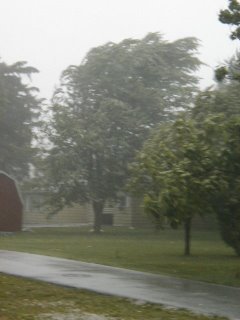 The Mighty Thor unleashed his fury upon us, on Thor's Day no less. A few hours after I posted the Magic Words blog, the small rural community I live in, plus the surrounding areas, was struck by Hurricane Force winds reaching 80 miles per hour and leaving a wake of destruction for us to climb up out of.
The Mighty Thor unleashed his fury upon us, on Thor's Day no less. A few hours after I posted the Magic Words blog, the small rural community I live in, plus the surrounding areas, was struck by Hurricane Force winds reaching 80 miles per hour and leaving a wake of destruction for us to climb up out of.Trees were felled, roofs torn off, powerlines clipped... Now, while the National Weather Service won't confirm it, locals were eyewitness to three tornados touching down between Sweetser (where I was working) and Converse (where I live). I actually got off pretty light.
While my workplace lost electricity until today, and 3/4 of Converse found themselves without power, my home only lost cable and internet (and a third of the roof that covered my laundry room).
It is times like these that we are all reminder just how small we are compared to the full might of Mother Nature (or the God of Thunder, for that matter).
While others ran cowering for cover, I stood my ground with my friend and co-worker Aaron and we marveled at the torrent that beset us. It was truly a magnificent display of wind, thunder, and lightning.
I love storms. I am energized by them. While I do not wish for the inconvience to others that such a storm brings (or in extreme cases, the loss of human life), I do relish in the Power, Mystery, and hammer of the Gods that storms of this magnitude inspire.
Rock On, Stormbringer...
Show us who's boss.
Thursday, June 22, 2006
Magic Words
 I don't think I'll be telling tales outside of school by stating that a writer's life is not easy, especially in the early stages of one's "career". For those of you who know the day to day struggle of trying to squeeze words out while juggling a job (or two), family commitments, technological malfunctions (damned computers) and extracurricular activities... I salute you and share your pain.
I don't think I'll be telling tales outside of school by stating that a writer's life is not easy, especially in the early stages of one's "career". For those of you who know the day to day struggle of trying to squeeze words out while juggling a job (or two), family commitments, technological malfunctions (damned computers) and extracurricular activities... I salute you and share your pain.We write out of love and passion for an art that is sadly becoming lost. Our audience has dwindled to the point of near extinction while more and more of us put word to paper in the hopes that maybe, just maybe, someone out there will take notice and be entertained by the yarns we spin.
I know that, if writing were my sole profession, I would be extremely prolific. I have never known "writer's block". As the creator of Charlie Brown used to say, "Writer's Block is for amateurs". That being said, time is my enemy, as it is the enemy of many writers that find themselves in the same situation as I do. But still we champion on, donning our armour and brandishing our sword against the great and terrible beast that seeks to pull us from our Quest. With words we feint and parry against the dark abyss' minnions and we strike a blow against this evil and relish in whatever word count that can be mustered.
In the end it is all about the words, isn't it? The collection of magic symbols that we knit together by way of cryptic spell, invoking the Gods of Prose and petitioning them for their blessing as we construct the incantations that will carry our audience away from the real world for a time... depositing them into worlds of our own creation.
I raise a horn to you, the writer, and I am humbled to count myself among your number. We are the wordsmiths, and though we may be unheralded, still we endure and press on.
Write on...
Wednesday, June 21, 2006
The Conqueror Worms
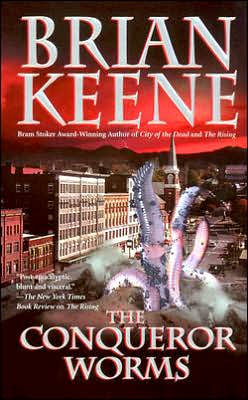 A Non-Spoiler Review of Brian Keene's The Conqueror Worms:
A Non-Spoiler Review of Brian Keene's The Conqueror Worms:You want to know what I like about Brian Keene? He writes movies. Not just any movies, but summer blockbuster, roller coaster horror movies. Oh, they're novels, don't get me wrong. There's words and everything. What I mean is that Keene has a gift for pacing. His stories race from beginning to end. He doesn't bog the reader down with endless exposition or finely crafted sentences that elevate the English language. No, he tells you a damn story, and you'd better hold on, because these tales are being told with the pedal to the floor, full steam ahead, and damn the torpedoes...
The Conqueror Worms is no different. Keene is hitting on all cylinders with this balls-to-the-wall tale about two old West Virginia good old boys being terrorized by giant earthworms, among other things equally bizarre. Keene's characters are unique and vivid. Our primary protagonist Teddy Garnett tells this story of a global flood that has crippled humanity as he lays dying on the floor of his mountain home. This makes the story even more piognant. We go into the story with the knowledge of our hero's impending fate, and still the narrative pulls us along...
Sure, there are points when the dialogue hits a snag or two, but overall this has been perhaps Keene's finest hour. The Conqueror Worms was apocalyptyic fun and I give it my highest recommendation.
Tuesday, June 20, 2006
Children of the Sun, Rejoice!!!
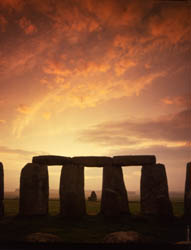 SUN worshippers are preparing to celebrate the annual Summer Solstice at Stonehenge.
SUN worshippers are preparing to celebrate the annual Summer Solstice at Stonehenge. At 04.58 tomorrow an estimated 20,000 people will witness the sunrise following an all-night party at the ancient stone circle on Salisbury Plain.
Every summer the event draws an eclectic mix including Druids, hippies and hedonists as well as people who want to experience what has become a traditional start to the longest day of the year. English Heritage, which manages the 5,000-year-old site, allows people to gather around the stones for the annual event.
In recent years curious things have happened when the sun appears over the Heel Stone to the sound of beating Pagan drums.
Revellers have been known to frolic naked. Some chant, some shout, while others sit meditating. Wiltshire Police will be attending this years event to ensure order is maintained.
A force spokesman said: "We're expecting between 20,000 and 25,000 people. A lot will probably arrive in the early hours of the morning after having watched England play Sweden."
A spokesman for English Heritage said: "Were hoping for a great sunrise. Last year's was spectacular. There's always a good atmosphere here."
A smaller crowd is also expected to gather 30 miles away at the ancient stones in Avebury, where solstice celebrations are traditionally said to be more chilled-out than those at Stonehenge.
Monday, June 19, 2006
Odd Occurrences at the Odd Fellows
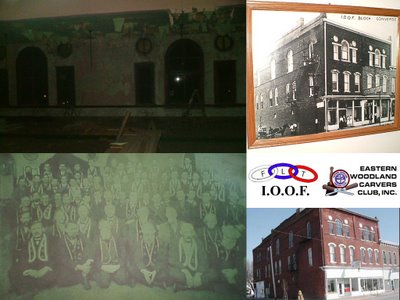 Members of the Wabash Paranormal Investigation and Research Group met Saturday Night at 9:30 pm to begin a thorough investigation of the Eastern Woodland Carvers Club, a three story building on the corner of Jefferson and Washington in downtown Converse. Preliminary investigations showed steady, low-level EMF readings... nothing to go into detail about. I personally feared that the night would prove to be uneventfull. It was not long before I would be proven wrong...
Members of the Wabash Paranormal Investigation and Research Group met Saturday Night at 9:30 pm to begin a thorough investigation of the Eastern Woodland Carvers Club, a three story building on the corner of Jefferson and Washington in downtown Converse. Preliminary investigations showed steady, low-level EMF readings... nothing to go into detail about. I personally feared that the night would prove to be uneventfull. It was not long before I would be proven wrong...Sunday, June 18, 2006
Did you hear that?
Friday, June 16, 2006
something insidious coming your way this July
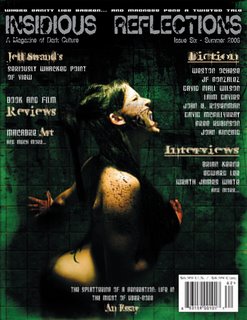 Insidious Reflections #6
Insidious Reflections #6John B. Rosenman - The Milk of Human Kindness/ Art - LeeAnn Karpel
JF Gonzalez - Out of the Cradle/Art - Jen Galasso
David Niall Wilson - They're Everywhere/Art - Will Renfro
Greg Rubinson - The Survivor/Art - Derick Haight
Weston Ochse - The Last Love of Cary Grant/Art - Tom Moran
David McGillveray - Sensation/Art - Jason Beirens
John Kincaid - The Church Grim/Art - Zach McCain
Liam Davies - The Smile Thief vs. The Child Thief/Art - Cort Skinner
All of this for a mere $5.99 cover price.
Available at www.shocklines.com www.insidiousreflections.com or your local bookstore.
Wednesday, June 14, 2006
Are you ready for... the Garden

On July 11th IDT Entertainment's Anchor Bay Entertainment, the acknowledged industry leader in horror DVD programming, presents the DVD premiere of The Garden , the latest exercise in terror from the fertile mind of acclaimed writer/producer Stephen J. Cannell (“The A Team”, “Hunter”, “Profit”, “21 Jump Street”).
Starring Lance Henriksen ( Aliens, Near Dark ), Claudia Christian (“ Babylon 5,” The Hidden ) and Sean Young ( Blade Runner, Stripes ), The Garden digs deep into the greatest fears of civilization itself and will take viewers on a mind-bending journey, possibly to the end of times! Seeded with a bushel of value-added bonus features including audio commentary from the director and exclusive behind the scenes footage, The Garden promises a harvest of thrills for the casual and ardent “horror”-ticulturalist! SRP is $19.98 and pre-book date is May 31st.
Sam (Adam Taylor Gordon) is a boy with big problems: he is besieged by nightmares (sometimes religious in nature), he cuts himself and he's recently been released from a mental hospital. When he and his recovering alcoholic father (Brian Wimmer) are involved in an auto accident, they are forced to stay on a ranch owned by the enigmatic Ben Zachary (Henriksen). Soon, Sam's dark visions become frighteningly real. Even Sam's benevolent teacher (Young) gives no comfort. Amid the wheat stalks and horse trails, the dead walk, evil is everywhere and Sam fears that an apocalyptic prophecy might come to pass.
Produced by Stephen J. Cannell and Michael Dubelko, directed by Don Michael Paul and written by Samuel Bozzo, The Garden is a provocative horror thriller about the battle for the soul of mankind – waged within all of us.
Anchor Bay has harvested bountiful supply of bonus features for The Garden DVD , including:
Widescreen Presentation (1.77:1), enhanced for 16x9 TVs
Audio Commentary with Director Don Michael Paul
The Garden: Behind-The-Scenes
Still Gallery
Lance Henriksen Bio
Trailer
THE GARDEN
Street Date: July 11, 2006
Pre-Book: May 31, 2006
Catalog #: DV14358
UPC: 0-1313-14358-9 4
Run Time: 92 Minutes
Rating: Not Rated
SRP : $19.98
unleashing my not-so-inner geekness

This image is a graphic representation of the structure of my Cairnwood.net index page, generated using this tool.
The dots are color-coded as follows:
blue: for links (the A tag)
red: for tables (TABLE, TR and TD tags)
green: for the DIV tag
violet: for images (the IMG tag)
yellow: for forms (FORM, INPUT, TEXTAREA, SELECT and OPTION tags)
orange: for linebreaks and blockquotes (BR, P, and BLOCKQUOTE tags)
black: the HTML tag, the root node
gray: all other tags
Take a peek at some of your favorite websites... they are gorgeous.
Tuesday, June 13, 2006
Robert E. Howard Remembered
 CROSS PLAINS, Texas (AP) -- Along Main Street near a feed store and senior citizens' center emerges Conan the Barbarian, his dark hair flowing past his broad shoulders and his muscular arms clutching a sword dripping with blood.
CROSS PLAINS, Texas (AP) -- Along Main Street near a feed store and senior citizens' center emerges Conan the Barbarian, his dark hair flowing past his broad shoulders and his muscular arms clutching a sword dripping with blood.It's certainly an unexpected sight in a rural West Texas community, but the library building mural symbolizes the town's claim to fame: native son Robert E. Howard, the character's creator.
Every June for the past 20 years or so, people from around the world have trekked here to attend lectures about Howard. They also tour the white clapboard house where he sat at a small wooden desk, peered out of the window at the peaceful West Texas prairie and on his Underwood typewriter spun tales of sword-wielding heroes from other centuries.
For this year, what would have been Howard's 100th birthday, organizers had been planning to expand the celebration to three days in hopes of attracting up to 300 fans, triple the attendance of recent years.
But nearly six months ago a wildfire ravaged this rural community, killing two women and destroying a church, 90 homes and thousands of acres. The flames also came within 3 feet of the Howard home's front steps.
As Cross Plains started rebuilding, folks decided to forge ahead with the festival plans -- not only to help the town get back to normal but also to give it a much-needed financial boost.
"I had no doubt that the Howard Days would go on," said Rusty Burke, a member of the Robert E. Howard United Press Association, which studies the author's life and works. "I knew people would want to come, and thought, 'We need to do what we can to keep the money in Cross Plains.' "
The event helps the local economy, although some Howard fans spend the night elsewhere because the town doesn't have many hotel rooms. Still, Burke said, he nixed plans for a banquet in a nearby city with bigger facilities because he wanted all activities in Cross Plains.
Now, green grass and new houses have sprouted up all over town. The only reminders of the December 27 tragedy are a few empty parcels, neat and void of debris, and the First United Methodist Church brick sign on a large vacant lot.
Although the Howard house was spared in the blaze, a fire truck plowed through part of its white picket fence as firefighters rushed to help a neighbor douse the building to protect it. The fence was repaired in time for Robert E. Howard Days, which ran June 8-10, and fresh grass has grown over the once-blackened lawn.
Cross Plains hasn't always embraced its most famous native son, sometimes called "crazy" for his wild tales, talking to himself and sometimes pretending to box while walking down the street. Those negative feelings intensified for some when he committed suicide at age 30 after learning that his ailing mother would not awaken from her coma.
Although many assume Howard was distraught because he was too close to his mother, signs indicate he had been considering suicide -- although he had several close friends -- and shot himself in the head when he no longer had to tend to his mother, Burke said. She died the next day.
But his popularity grew as his works were published in paperbacks in the 1960s. Then his Conan character -- a thief, mercenary and pirate who slayed dragons, winged apes and savage tribes on his way to becoming a king thousands of years before recorded history -- was featured in comic books in the 1970s. They inspired the 1982 movie "Conan the Barbarian" starring Arnold Schwarzenegger.
While the movie plot differed from Howard's tales -- which, like his stories about other characters, had been published only in "Weird Tales" and other magazines before his death -- it widened the audience and made Conan part of pop culture.
Through the years, fans went to Cross Plains expecting to tour Howard's house, and when they were turned away by the annoyed homeowners, a few visitors tore off pieces of the fence as souvenirs.
Seeing an opportunity for historic preservation and tourism, a newly formed community group called Project Pride bought Howard's run-down former house in 1989. The volunteer members pooled their money for the down payment, then held bake and garage sales and sought donations from out-of-town Howard fans.
But the $10,000 mortgage wasn't the only expense. Much work -- including removing the carpet and paneling installed by later residents -- was involved in restoring the house to its 1930s appearance.
The first Howard Days was in 1986, the 50th anniversary of Howard's death, a year after Burke and some friends first visited Cross Plains. The next event was in 1989 and has been held every year since with help from Project Pride, and attendance has grown from a dozen to nearly 100 people.
At first, the farming community of mostly retirees didn't know what to make of the self-proclaimed "sci-fi geeks and fantasy fans," some with long hair and tattoos. But the town realized how much the event helped the economy and now welcomes the guests -- who include teachers, doctors and businessmen.
"It's kind of like a family reunion," said Susan McNeel, a lifelong Cross Plains resident and Project Pride secretary. "It's fun for the local people to see people they haven't seen in a year or a few years."
Organizers and fans say they are glad that Cross Plains, about 115 miles west of Fort Worth, has recovered and the celebration was able to proceed this year.
"Howard was a very prolific, vivid writer, and people who like adventure get into his writing," said Burke, an aptitude testing organization director in Washington, D.C. "Fans like to see where a writer worked. The first time I came here, there were no exotic jungles, and I thought how little he had to work with, but now I've come to see how he took certain things and used his imagination."
Monday, June 12, 2006
I survived Mo-Con 2006
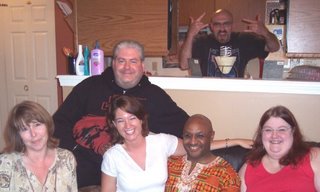 Maurice Broaddus and his lovely wife opened up there home for a gathering of writers and fans on Saturday evening. I made the two hour trip to the big city for the opportunity to shake hands with people who previously had been but words and avatars on various message boards. It was a trip that was more than worthwhile.
Maurice Broaddus and his lovely wife opened up there home for a gathering of writers and fans on Saturday evening. I made the two hour trip to the big city for the opportunity to shake hands with people who previously had been but words and avatars on various message boards. It was a trip that was more than worthwhile.The Indiana Horrow Writers Association were in attendance, and it was a thrill to meet them all. Michael West, Tracy Jones, Lauren David, Sara Larson, and Maurice, of course.
It was a pleasure to finally meet one of my favorite online posters, Carrie Rapp (aka valcarrie, aka musclechik), who was as joyful in person as I have found her to be online. I wish I would have had more time to chit chat with her...
Unexpected, but a treat none the less, was the irrepressible Chesya Burke and paranormal romance mavin Debbie Kuhn.
Brian Keene was the Guest of Honor and I had been anxious to meet the notorious author who has been firing the imaginations of so many in the horror community over the past few years. I was pleased to discover that the Brian Keene I had come to know on message boards was the same Brian Keene I met in person. Quick-witted and funny, Brian has a very easy going personality and a charismatic charm that is tempered only by a wicked tongue. I would go into detail about some of the things we discussed that night, but nearly every story Brian told was prequeled by a "this better not show up on your blog" warning... lol...
Conversation was fast and furious, ranging in topics from our mutual love for Days of Our Lives (well, Brian, Michael, and myself anyway) to cyber-stalkers and imbeciles. We chewed the fat over the state of the industry, how we got started, and what hurdles we had traversed. It was like a bunch of old friends getting together after years of being apart... laughing, drinking, and having a great time.
My only regret was not getting to join everyone for the Sunday Service at Maurice's church, where Mr. Keene was to give a sermon of sorts on his take on spirituality... Now that I would have loved to hear. Rumor is that there will be video... I can hardly wait.
Till next time...
~Bob
Saturday, June 10, 2006
Because you asked... What is Asatru?
 From Steve McNallen's Asatru Folk Assembly website:
From Steve McNallen's Asatru Folk Assembly website:Asatru is an expression of the native, pre-Christian spirituality of Europe. More specifically, it is the Way by which the Germanic peoples have traditionally related to the Divine and to the world around them.
From Iceland to Russia, from the frozen north of Scandinavia to the Mediterranean, the Germanic peoples wandered and settled over a span of thousands of years. Today, their descendants are spread around the world. We may refer to ourselves as Americans or English, Germans or Canadians, but behind these labels lurks an older, more essential identity. Our forefathers were Angles and Saxons, Lombards and Heruli, Goths and Vikings - and, as sons and daughters of these peoples, we are united by ties of blood and culture undimmed by the centuries.
Asatru is our native Way. Just as there is Native American religion and native African religion, so there is native European religion. Asatru is one of its expressions. It gave our ancestors comfort in millennia past, and it can give us strength and inspiration today.
The word "Asatru" comes to us from Old Norse, the tongue of ancient Scandinavia, where it means "those loyal to the Gods." Since the ancient Scandinavian version of our Way is the best documented, it has given us much of Asatru's terminology and imagery. The soul of Asatru, however, is not confined to the Scandinavian model, but encapsulates the belief of all the Germanic peoples. Indeed, Asatru reflects the deeper religiosity common to virtually all the nations of Europe.
As a part of the great European Folkway, Asatru has a number of characteristic beliefs. Some of these are:
The world is good.
Prosperity is good.
Life is good, and we should live it with joy and enthusiasm.
We are free to shape our lives to the extent allowed by our skill, courage, and might.
There is no predestination, no fatalism, no limitations imposed by the will of any external deity.
We do not need salvation. .. all we need is the freedom to face our destiny with courage and honor.
We are connected to all our ancestors. They are a part of us. We in turn will be a part of our descendants.
We are also linked to all our living kin - to our families and to every man and woman rooted in the tribes of Europe. They are our "greater family."
We are connected to Nature and subject to its laws. The Holy Powers often express themselves in Nature's beauty and might.
We believe that morality does not depend on commandments, but rather arises from the dignity and honor of the noble-minded man and woman.
We do not fear the Holy Powers, or consider ourselves their slaves. On the contrary, we share community and fellowship with the Divine. The Holy Powers encourage us to grow and advance to higher levels.
We honor the Holy Powers under the names given them by our Germanic/Norse ancestors.
We practice Asatru by honoring the turning of the seasons…the ancestors…the Divine…and ourselves - in everyday life.
Asatru is about roots. It's about connections. It's about coming home.
Updated Upcoming Events Calendar
June 17: The Book Signing at Waldenbooks in Marion IN has been postponed until further notice. Downer that this news is, on the plus side, WPIRG and myself will be conducting a paranormal investigation of the I.O.O.F. Building in Converse in the later evening through early morning hours.
June 23-24: It's looking less and less like I'll be making the trip to Hypericon in Nashville TN. As much as I'd like to attend, money and family concerns have me questioning the logic behing the venture. I'll update you all further as we draw nearer the actual date.
July 4-8: I will assuredly be appearing at the Converse Fair, signing copies of my book, Shadows Over Somerset. This will be an excellent opportunity for me to get copies of SOS into the hands of the public, particularily that part of the public who would be especially impacted by the tale. Shadows takes place in a very real corner of the world, and it's a world the locals should be able to recognize. For a story that I feel is exciting and freightening enough for any reader that might pick it up, it should be doubly so for those people who grew up in the area
Beware: there's a new blogger in town
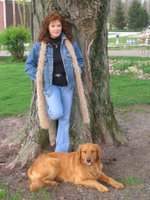 My good friend Joy Harber has dipped her toes into the Blogspot Universe. Joy is a talented author and poet and you might enjoy a little peek into her world.
My good friend Joy Harber has dipped her toes into the Blogspot Universe. Joy is a talented author and poet and you might enjoy a little peek into her world.http://thescratchingquill.blogspot.com/
Joy and I have been working on a collabrative novel, one that combines the strengths of our mutual writing styles. Tenatively titled, Wolves of Wintered Night, the novel will be a paranormal romance that goes a tad bit darker than the books you normally find in the genre. Keep your eyes peeled for it... and in the meantime you can check out our respective solo efforts, such as Joy's Rose's Kiss: The Legacy of Rhoslefain, Abbey Chronicles I or my own Shadows Over Somerset
Tuesday, June 06, 2006
Local Buzz Re: Shadows Over Somerset
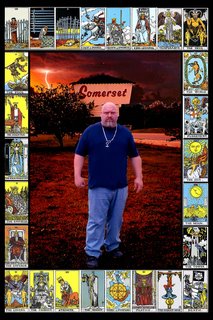 OK, this falls under the category of "Any Press is Good Press"... Full of misquotes, misrepresentations, and a couple other missives I won't go into... All that being said, here for your reading pleasure is the article ran today in my local paper.
OK, this falls under the category of "Any Press is Good Press"... Full of misquotes, misrepresentations, and a couple other missives I won't go into... All that being said, here for your reading pleasure is the article ran today in my local paper.Do you think they ran it on 06/06/06 on purpose? lol
Tale of witchcraft unfolds on Mississinewa
Man publishes book, works on Halloween sequel
BY TIM TURNER
CONVERSE - A pack of wolves howling in the night, the crazy old lady who lives at the end of the street, and the long trail leading to a secluded house are nothing more than a passing thought to the average person, but in the mind of Bob Freeman they are stories waiting to be explored.
Freeman has done just that with his novel Cairnwood Manor: Shadows Over Somerset.
Horror was as much a part of Freeman's childhood as the banks of the Mississinewa River. Despite working second shift, Freeman's father wanted to spend time with his son when he got home from work.
"He would come home from work and get me out of bed," Freeman said. "He would sit there and watch this show called Sammy Terry, and I would hide behind his chair watching all these classic horror films."
Soon after his exposure to horror films, Freeman began exploring a local graveyard at night for ghost.
Writing was also a passion of Freeman's.
"I would take comic books and rewrite the pictures I was seeing in the book."
Freeman continued writing in college, but focused mainly on academic papers, earning a degree in anthropology from Ball State University.
After college, Freeman took a hiatus from writing that lasted until 2000. Two days before Freeman was going to marry his wife, he lost his job. It was during his search for employment that Freeman was reintroduced to his love of writing.
"I would go out and look for a job, and I would come at night and go 'I need to do something,'"
Freeman's wife suggested he start writing, and while he continued looking for a job he began writing his novel Cairnwood Manor: Shadows Over Somerset.
"Every night she would get off of her job, and read what I wrote. It was this nice little bonding experience between us."
After a few quick rejections, Freeman got his novel in the hands of the director of development at Dimension Studios. Freeman spent two years working with Dimension trying to turn his manuscript into a feature film. In the end Dimension turned the film down. After spending two years rewriting the novel based on the suggestions of Dimension, the manuscript was back in Freeman's hands.
Freeman sent his novel to a publisher and it was picked up. The novel explores a world of witchcraft, werewolves and vampires set in the Mississinewa Reservoir area.
Freeman is already finishing up the sequel and hopes to see it published by Halloween of next year.
Monday, June 05, 2006
In appreciation of Jimmy Page
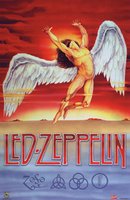 An excerpt from Erik Davis' Led Zeppelin (33 1/3):
An excerpt from Erik Davis' Led Zeppelin (33 1/3):In fairness, it must be said that many rock bards name Black Sabbath rather than Zeppelin as the true font of heavy metal. After all, Sabbath pack an unparalleled eldritch punch, and in many ways represent a purer source of bane: the riffs more consistently morbid, the stance more prole, and the whole shtick more out-of-nowhere and hence more monstrous, more contrary to nature. But Zeppelin had a vaster palette, a more richly perfumed darkness; perhaps most importantly, they sold way more records. Like all origin stories, this one depends on your frame of reference, your own lineages, your taste. It’s very much like the question of who deserves blame for the genre of heroic fantasy, whose multi-volume sagas of dwarf-lords and magic blades continue to clog the SF sections of bookstores. Hardcore sword-and-sorcery buffs will rightly name the pulp peregrinations of Robert E. Howard’s Conan, while more literary types will nominate, with equal justification, Tolkien’s Lord of the Rings. Sabbath is Conan; Zeppelin is Lord of the Rings.
But Zeppelin is a special sort of Lord of the Rings, one where you get to root for both sides. Whatever its biographical basis, Page’s apparent diabolism is counterbalanced with the bucolic hippie paganism concentrated in the lyrics, persona and hairstyles of Robert Plant. Led Zeppelin derives much of their mythic power from this seductive but disturbing ambiguity. Who do Zeppelin swear fealty to? The devil or the sun? Mordor or Middle-earth? Is Faery really just a theme park of Hell? The polarity between Page and Plant is even reflected in their very names. The plant is the pure green spunk of earth, whereas the page is a work of man, a skeletal void upon which we inscribe our plots and spells.
A similar polarity underlies Page’s persona, and helps to explain the aura of magical power that characterizes his mystique. Susan Fast cites one fan survey focused on the guitarist: "He is the sage. He knows how to take chances and make it work. He is the producer and ultimate architect of the goods." On the surface, Page’s live performances present typical rockist values of spontaneity, virtuosity, and sweaty abandon. But Page adds a novel element to the figure of the guitar hero, an element that Steve Waksman has identified as mystery. So even as Page bares his cock rock before tens of thousands of fans, the Zoso doodle emblazoned on his clothes and amp remind us that he knows something that we don’t. There is a gap between the hero whose performance we consume and the sage behind the curtain, who remains concealed, literally occult. This mystique makes Page far creepier than Ozzy, who is hiding nothing, except maybe his debt to The Munsters.
Though rooted in Page’s personal reserve and esoteric interests, the guitarist’s mystique is also structurally reflected in his musical practice. Page’s live virtuosity was leavened by the fact that he was notoriously sloppy, constantly picking up and discarding ideas with an air of carelessness, even distraction. In the heat of performance, it often seemed like a part of him was somewhere else, at a wise or possibly addled remove. Yet this sloppiness suggested that he had even mastered chance, and could “make it work.” This element of hidden mastery is the key, for behind the scenes, Page was an architect of control: a hands-on producer, a sometimes martinet in the studio, and a tight-fisted investor who, along with Peter Grant, helped wrest unprecedented financial and artistic control away from his record company. This air of cunning underlies his mystique. Onstage, he would occasionally direct the other members like a conductor, a performance that Jones has insisted was largely for show.
Saturday, June 03, 2006
Upcoming Events
 June 3: A daytime walk-through of the former I.O.O.F. Hall with the Wabash Paranormal Investigation and Research Group (W.P.I.R.G.). We will be mapping the site for a future in depth investigation.
June 3: A daytime walk-through of the former I.O.O.F. Hall with the Wabash Paranormal Investigation and Research Group (W.P.I.R.G.). We will be mapping the site for a future in depth investigation.June 6: The Day of the Beast :) I was interviewed by the Chronicle Tribune concerning my novel SHADOWS OVER SOMERSET and the article should appear in the Tuesday edition of the paper.
June 10: I will be travelling to Indianapolis as a guest of the Sinister Minister, Maurice Broaddus, for a gathering of horrific authors and fans. Brian Keene, Michael West, and Steven Shrewsbury, among others, are expected to be in attendance.
June 17: I hope to have a book signing event at Waldenbooks in Marion IN. I'll provide more details on this as I learn them.
June 23-24: I "might" be able to swing a trip to Hypericon in Nashville TN. This is extremely tenative.
July 4-8: I will be appearing at the Converse Fair, signing copies of my book.
Friday, June 02, 2006
One Land... One King
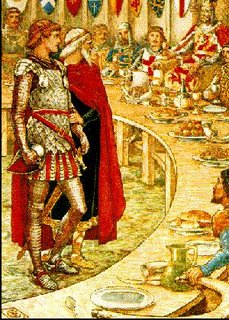 Arthur's Seat in Edinburgh could have been the base of the Gododdin tribe and their warrior Arthur.
Arthur's Seat in Edinburgh could have been the base of the Gododdin tribe and their warrior Arthur.King Arthur's Scottish Camelot
by DIANE MACLEAN
THERE are few heroic figures like King Arthur. Tales of his chivalric bravery - and that of his knights of the round table - remains as enduringly popular today as they were over 1,000 years ago when romances concerning these knights were first published.
The traditional setting for Arthur and his court at Camelot is in either Cornwall or Wales. Legend tells of a kingly man who pulled swords out of stones, protected England and eventually sent his men to quest for the Holy Grail. But what if this interpretation is all wrong?
A number of authors down through the ages have suggested that Arthur - this most English of heroes - was in fact from Scotland, a story if true that would stand history on its head.
King Arthur and his knight appear in art, literature, film and music - such is their popularity.
What we now refer to as Scotland didn't exist in the period during which Arthur is said to have lived. In the 6th century Scotland was tribal. The people living in and around Edinburgh and southwards into what is now the North of England were known as the Votadini – or Gododdin. It is in a 6th century poem Y Gododin that the first ever mention of Arthur appears in print:
"… one Gwallawg who 'although he fed the ravens, was no Arthur'."
This remark acknowledges the fighting spirit of Gwallawg, who offers plenty for the ravens to pick upon in battlefields, but cannot compare with the fighting prowess of the mighty Arthur. The reference suggests that Arthur was a well-known figure at the time.
The next appearance of Arthur in literature appears in Adomnan's Life of St Columba. Written in the 7th century it tells the story of St Columba – an Irish monk who built the monastery on Iona. This book mentions a 6th century prince, Arturius, the son of Aidan who died fighting the Miathi Picts.
The main source of the "mythologising" about Arthur derives from the writings of Geoffrey of Monmouth whose 1138 Historia Regum Britanniae firmly locates Arthur as a British King and sets out his exploits with his knights and Merlin. This book provided the main basis for all subsequent Arthurian legend and places him in the South of England.
Yet this book is no barrier for authors like Stuart McHardy who writes in his book On the Trail of the Holy Grail:
"It seems the idea that Arthur simply couldn't be Scottish has taken a firm root, as have so many interesting, even quaint notions regarding the Grail itself, despite what common sense would suggest."
McHardy's "common sense" argues that because Scotland was effectively cut off from the rest of the UK - in that it was never fully or even properly occupied by the Romans - it remained tribal with a predominately oral culture. It came late to the practice of writing down traditional stories. McHardy thinks that to suggest Arthur is Welsh or English just because he appears in literature from these locations is simplistic. He moots that Arthur was Scottish, but well-known enough to appear in stories many miles away.
Further support of Arthur's nationality is suggested by looking closely at the locations of the 12 battles the warrior is said to have fought. The Victorian historian WF Skene has located all of the battles fought by Arthur - in Scotland. In doing so Skene follows on from a tradition by Nennius, a 9th-century historian whose Historia Britonum also argues for Scottish battlefields.
Most of the battle locations have Arthurian names: Arthur's Craigs in the west of Lanark; Arthurshiels Farm, north of Biggar; Loch Arthur in Dumfries, and so on to Arthur's Seat in Edinburgh.
McHardy takes the trail of the battles further and suggests that they represented a campaign. He proposes that Arthur was involved in a crusade to re-Christianise the pagan north.
Although Christianity had existed in Scotland, it was neither widespread nor conclusive. Areas that had embraced the faith sometimes slipped back into paganism. McHardy's portrayal of Arthur as a powerful warrior who came to stamp out paganism would also account for the longevity of the Arthur myth.
"If he was involved in what was effectively a Christian crusade, his ongoing importance within the different oral traditions may well have stemmed from the fact that Christianity was triumphant in Britain," he says in his book.
If Arthur lived and fought in Scotland, then perhaps he found his sword Excaliber embedded in a rock somewhere outside Edinburgh.
Those who seek a Scottish Arthur take inspiration in the possible Scottish heritage of key figures from the legends. French romance novels from the 13th century have Lancelot as the son of King Ban of Benwick – or Bannock. Others have him as the son of King Lot of the Lothians. Sir Galahad too is given a Scottish pedigree by a number of medieval writers.
Guinevere also has her place in Scottish mythology. Outside Meigle, in Perthshire, a Pictish standing stone is said to depict Guinevere's death. She is shown being pulled apart by dogs, punishment for her infidelity.
There has long been a Scottish connection with Merlin. The Merlinus Caledonensis, or Myrddin Wyllt, was a wild man who is said to have lived in the Caledonian forest after being driven wild with grief at seeing the death of his lord. A number of Merlin place names remember this figure – thought of by some to have been a druid.
The proliferation of Arthur place names is also cited as proof of a Scottish connection. Beyond Arthur's Seat you have the possibility that the Island of May was the Isle of Avalon, Camelon in Falkirk was Camelot and that the round table is still remembered outside Stirling.
But surely if Arthur was indeed of Scottish origin then the final proof would be the presence here of the Holy Grail.
Did somebody just mention Rosslyn???
